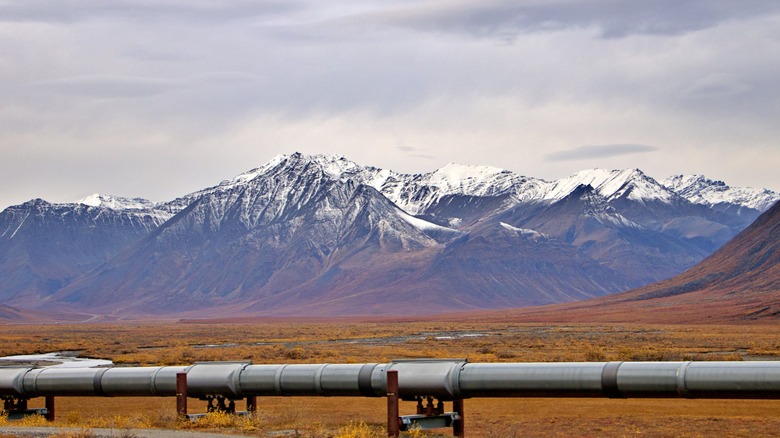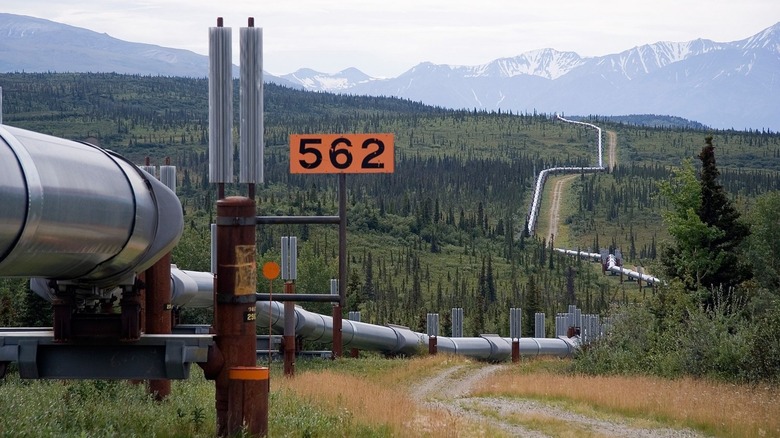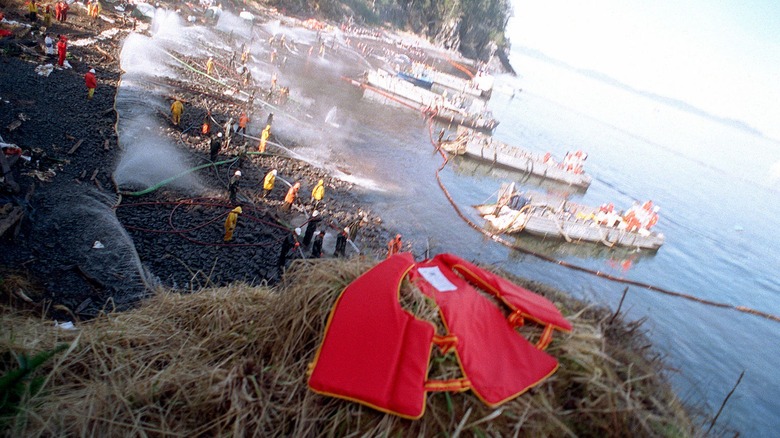How Long Is The Trans-Alaska Pipeline And How Much Oil Does It Carry Daily?
Alaska is the biggest state in the U.S. by area, so you can expect any oil pipelines making its way across its territory to be fairly long. In fact, the Trans Alaska Pipeline System (TAPS) is one of the largest pipeline systems in the world. Constructed between 1974-1977, TAPS is very important for both Alaska's economy and energy security for the U.S. as a whole. While you might picture glaciers and polar bears when you think of Alaska, it's one of the top oil-producing states in America (even cars in Alaska with plugs run on gasoline).
Pipelines play a crucial role in how oil and gasoline are produced, transporting the fossil fuel across long distances and connecting wells, refineries, and shipping facilities. The trans-Alaska pipeline is a whopping 800 miles long, extending from Alaska's North Slope off the coast of the Arctic Ocean all the way to Port Valdez, which is part of the Gulf of Alaska and the Pacific Ocean. It's the northernmost ice-free port in North America, which makes it vital for shipping and trade in the region.
Along the 800 miles of TAPS are 11 pump stations, which keep the massive quantities of oil moving by maintaining pressure within the pipeline. Originally, 12 stations were supposed to be built and today just four are operational. Fewer pumps are needed, as the system moves a lot less petroleum than it used to — in 2024, it transported 464,784 barrels of oil per day. Since one barrel is equivalent to about 42 gallons, that equates to around 19,520,928 gallons or 29.5 Olympic-sized swimming pools. While that may seem like a lot of oil, it pales in comparison to the 2.1 million barrels of crude oil that the trans-Alaska pipeline carried daily at its peak, which was in 1988.
The Trans-Alaska Pipeline runs every day, but it can't hide
Many oil pipelines run primarily underground, similar to sewer pipes, but TAPS is different. Because much of Alaska's terrain is made up of permafrost — frozen soil that is difficult to dig — more than half of the pipeline is above ground. Alaska is known for its gorgeous landscapes, much of which is still uninhabited today, and you can find the pipeline extending across many of these serene vistas. Over its 800-mile length, the Trans-Alaska pipeline crosses three different mountain ranges, hundreds of rivers and streams, and even three major earthquake faults.
The pipe is made up of 48-inch diameter high-tensile carbon steel so that it can withstand the vast amounts of crude oil it carries, as well as last for decades. The thickness of its walls range from 0.462 to 0.563 inches and it can operate at pressures of up to 1,180 psi, with 71 gate valves and 80 check valves that can block oil flow as safety precautions dictate. The pipeline can stop oil flow in just four minutes if needed. The lower the flow levels, the slower the oil can travel — today, it takes about two weeks for petroleum to traverse the pipeline end to end.
TAPS is built to last, but its days might be numbered for a couple of reasons. There may not be much oil left to transport, as much of it has already been mined from Alaska's North Slope. Estimates for potential end dates for the pipeline range from 2032 to 2065. Climate change and the thawing of Alaska's permafrost also threaten the integrity of the pipeline — thousands of thermosyphons, which draw heat from and slow the warming of the ground, have been installed along its length to help mitigate this.
TAPS is connected to one of the most famous oil spills in history
The company installing the thermosyphons to try and keep the permafrost solid and extend the life of TAPS is the Alyeska Pipeline Service Company, which operates and maintains the system. TAPS is owned by multiple different pipeline and energy companies, including Harvest Alaska, ConocoPhillips Transportation Alaska, and the ExxonMobil Pipeline Company. That last name might sound familiar — and not because you've refilled your tank at your local Exxon. One of the most famous oil spills in history, which occurred in 1989, was the Exxon Valdez disaster.
While it wasn't one of the two largest oil spills in history, the Exxon Valdez spill comes close. It occurred in the Prince William Sound as the supertanker Exxon Valdez was leaving the Valdez Marine Terminal to transport crude oil, originally carried from the Trans-Alaska Pipeline, to Long Beach, California. Around 11 million gallons (over 250,000 barrels) spilled into the water, affecting 1,300 miles of shoreline. Thousands of fish, birds, and aquatic mammals were killed, including whales, seals, otters, and eagles, as well as billions of fish eggs. The ecological disaster helped boost awareness of environmentalism and led to Congress passing the Oil Pollution Act of 1990.
The spill was caused by the ship running aground, but the oil had already safely made its way across TAPS from Alaska's North Slope to Port Valdez. The pipeline itself has been breached before, though — at least 18 times since the turn of this century. Some spills were as little as one barrel, but altogether add up to at least 9,784 barrels of leaked oil, which is just a fraction of the Exxon Valdez spill.


